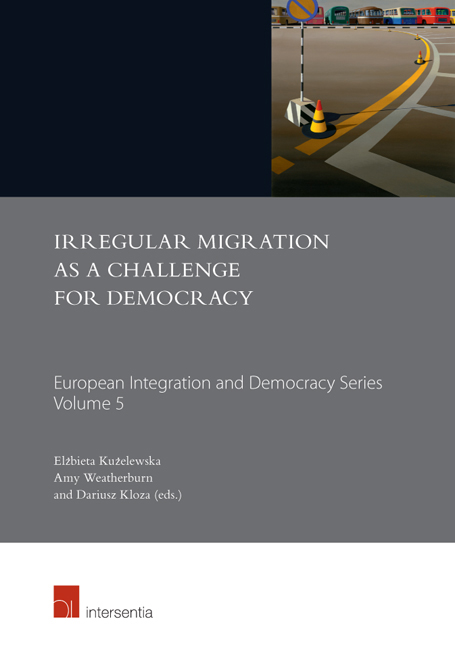Book contents
- Frontmatter
- Foreword
- Introduction
- Contents
- List of Abbreviations
- PART I The European Integration Project And Irregular Migration: Upholding Fundamental Values And Principles
- 1 The ‘Migrant Crisis’: Member States’ or EU's Responsibility?
- 2 Solidarity in EU Asylum and Migration Law: A Crisis Management Tool or a Structural Principle?
- 3 EU Foreign Policy and Other EU External Relations in Times of Crisis: Forcing the Law to Overlap?
- 4 The Migration Crisis in Europe: The Implications for Trade and Labour in a Globalised Context
- 5 Has the Migration Crisis Challenged the Concept of the Protection of the Human Rights of Migrants? The Case of Ilias and Ahmed v. Hungary (Invited Contribution)
- 6 European Responses to the Mediterranean ‘Refugee Crisis’ and the Fear of Saving Lives (Invited Contribution)
- Part II Migrants, their Rights and the Limits Thereof
- Part III The Status Quo of Migration in Europe: Selected National Perspectives
6 - European Responses to the Mediterranean ‘Refugee Crisis’ and the Fear of Saving Lives (Invited Contribution)
from PART I - The European Integration Project And Irregular Migration: Upholding Fundamental Values And Principles
Published online by Cambridge University Press: 12 October 2018
- Frontmatter
- Foreword
- Introduction
- Contents
- List of Abbreviations
- PART I The European Integration Project And Irregular Migration: Upholding Fundamental Values And Principles
- 1 The ‘Migrant Crisis’: Member States’ or EU's Responsibility?
- 2 Solidarity in EU Asylum and Migration Law: A Crisis Management Tool or a Structural Principle?
- 3 EU Foreign Policy and Other EU External Relations in Times of Crisis: Forcing the Law to Overlap?
- 4 The Migration Crisis in Europe: The Implications for Trade and Labour in a Globalised Context
- 5 Has the Migration Crisis Challenged the Concept of the Protection of the Human Rights of Migrants? The Case of Ilias and Ahmed v. Hungary (Invited Contribution)
- 6 European Responses to the Mediterranean ‘Refugee Crisis’ and the Fear of Saving Lives (Invited Contribution)
- Part II Migrants, their Rights and the Limits Thereof
- Part III The Status Quo of Migration in Europe: Selected National Perspectives
Summary
INTRODUCTION
Public and policy debates around how to respond to and tackle the so-called European ‘refugee crisis’ have been dense, and with seemingly few immediate solutions at hand. They have covered everything from how to receive migrants arriving on the shores of Europe, how to process asylum claims and how to integrate newly arrived migrants, to how to reinforce border controls, strengthen asylum processing capacities and improve or find mechanisms for returning migrants – whether still on their way to Europe or after their arrival. A key and recurrent issue within this debate, a sort of node between the administrative, security and humanitarian concerns, is the question of whether providing assistance and relief also creates a so-called ‘pull-effect’ by encouraging more migrants to make the perilous journey. The suggestion is seen as controversial and has been refuted in several studies, yet it appears to be particularly resistant, and remains an underlying assumption in many of the policies formulated by the European Union (EU) as well as national and local governments.
Indeed, much of the debate around how to respond to and tackle the refugees arriving in Europe is framed around the question: what assistance should be provided that does not send a signal that encourages more migrants to come? Most arguments in the debate can be organised along an axis between those who believe that rescue efforts do constitute a pull factor, and such rescue should thus be limited, and those who either claim they do not, or refute the question itself, emphasising that in any case providing such life-saving assistance is a fundamental moral and humanitarian duty. This chapter will look more closely at the nature of this debate, seeking to understand how the ‘pull-effect’ has become a key premise in the debate thereby influencing responses and stances taken by different stakeholders, at sea as well as on land. It takes part in a broader academic discussion, where the rising awareness over recent years of the human suffering entailed by the multiple attempts to defy European border control structures, and the following humanitarian forms of responses, have led to the conceptualisation of ‘humanitarian borders’.
- Type
- Chapter
- Information
- Irregular Migration as a Challenge for Democracy , pp. 113 - 122Publisher: IntersentiaPrint publication year: 2018



